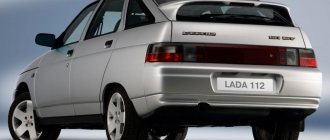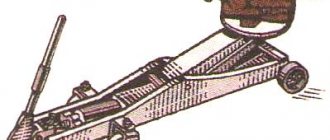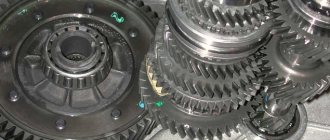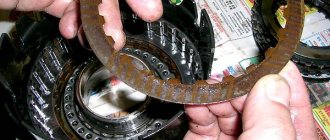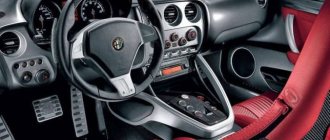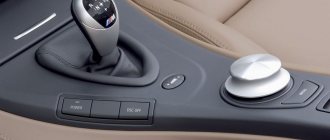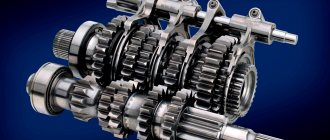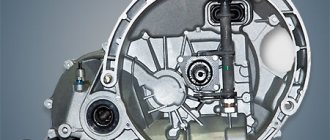When the time comes to learn to drive, many students are faced with the question of which automatic transmission to learn to drive. There is an automatic transmission and a manual transmission. So what are these letters? Automatic transmission - what it is is not entirely clear. This is nothing more than the ability to drive a car in automatic mode. The driver can only learn to decipher the symbols on the automatic transmission, which are located on the panel near the mode switch lever. Today we will look in detail at what the letters on the automatic transmission box mean.
What is an automatic transmission
An automatic transmission is essentially a transmission. Automatic Transmission The abbreviation is as follows - Automatic Gearbox. Switches speed modes (increasing and decreasing speed) without driver intervention. The person behind the wheel can only set the direction and use the gas and brake pedals (there is no clutch pedal), and then steer.
The clutch is performed by the gearbox itself. The automatic transmission also selects the right moment to change speed. Gears shift without jerking, smoothly. Driving a vehicle is greatly simplified, unlike mechanics, which are completely controlled by the driver. Manual transmission decoding - Manual Gearbox. Transmission option decoding – Gearbox. Switching is performed by a mechanical drive.
Designation of gearbox types
Different types of automatic transmissions have different names from each other, which are contained in easily recognizable abbreviations. Knowing what the letters mean, you can understand from the car manual which gearbox it is equipped with and what it is capable of. In modern cars there are:
- CVT or Continuous Variable Transmission, or simply “variator”. It features continuously variable gear shifting. The boxes operate very smoothly, but their reliability is somewhat lower than that of conventional automatic machines.
- DSG, or Direct Shift Gearbox. This gearbox is robotic and has two clutches. It is based on a manual gearbox, improved by an electric control module and servos, with the help of which gears are changed.
- AT or automatic transmission. It is a classic hydromechanical design. It is very reliable, as it is time-tested.
- MTA or Manual Transmission Shifted Automatically, or "robot". The name speaks for itself - this gearbox is completely robotic. It doesn't have a clutch pedal.
What these or those letters mean can be found out both from the manufacturer, seller, and in open sources on the Internet. Don't act at random when driving a new car. It is better to familiarize yourself in detail with the capabilities of the existing gearbox in order to use it correctly in the future 100%.
Automatic transmission modes
In an automatic transmission, as in a manual transmission, there are several speed levels. The lever switches functionality - modes. We have already found out how the gearbox is deciphered, now let’s look at the modes and their letter designations:
- N (Neutral) – neutral. Position without speeds. The mode is used when towing a car, for example. Some drivers, when stuck in traffic jams, put the lever in the neutral position, because keeping your foot on the brake pedal for a long time is not very comfortable;
- D(Drive) or A (Automat) – movement. By moving the lever to this mode, the driver begins to move, the car starts moving and all he has to do is steer and press the pedals;
- R (Revers) – reverse gear. The position is used to move the vehicle in reverse. It turns on only after a complete stop. While driving, it is strictly prohibited to move the lever to mode D;
- P (Parking) – stop. After stopping movement, the lever is placed in position P. This guarantees that the car will not roll, because the mode blocks the wheels. It is forbidden to turn on while driving. In most models, the engine will not start if the lever is not set to P mode;
- M (Manual) – manual control. The driver can change gears himself using the “+” and “-” buttons located on the lever or on the steering wheel. Different models vary;
- L (Low) or l; 1; 1L – slow. In this position, the car will only move in first gear. It is also used on slippery roads, steep descents and ascents, or for engine braking;
- L2, 2L or just 2 – in this mode, driving will be limited to the second speed and will not switch higher;
- D3 or number 3 – movement no higher than third speed;
- D4 or 4 - the car will shift to fourth gear. It will not go to 5 and 6;
- OD (Over Drive) – overdrive. The mode is activated by a button at a speed of at least 75 km/h. Providing stable driving on the highway, it saves fuel;
- KD (Kick Down) – low gear. It turns on itself if you squeeze the gas all the way. Helps to quickly gain speed;
- B (Block) – differential lock. Found on all-wheel drive vehicles and jeeps. Used when driving on rough terrain, off-road;
- S (Sport) – sporty. The mode uses engine power to its fullest. In this position, it becomes possible to accelerate the car sharply. More fuel is burned than usual;
- E – savings. On the contrary, fuel is used sparingly because the position ensures smooth movement;
- W (Winter) or snowflake - winter. When in the on position, slipping on ice is eliminated. The car starts at 3-4 speeds, then switching them at lower speeds and leveling out the acceleration difference. Cannot be used in summer to avoid overheating of the torque converter.
In different models of cars with automatic transmission, other designations may also be found. You should always read the instructions and manuals carefully.
What do the letters on the automatic transmission mean or the meaning of the buttons on the automatic transmission lever?
Such buttons can be either on the shift knob itself or near it:
- OD - or known as (Over Drive) is similar to mode 3 or D3 - made so that when driving, for example, at a speed of 60-80 km/h, your transmission constantly clicks, switching from 3 to 4 and vice versa from 4 to 3 gear, so that this did not happen, turn on the OD , in fact, this mode automatically activates mode 3, which means you will move in 3rd gear
- M - translated as Manual, that is, manual control, you can choose when to turn on and what speed to turn on in your car, this is usually done with the + and - buttons either on the speed lever or on the steering wheel or with the paddles behind the steering wheel or under the steering wheel
- S – or otherwise (Sport) not all gearboxes are equipped with it, sport mode implies more active movement and speed gain, which, of course, will affect fuel consumption
- W or Snow sometimes also draw a snowflake - which means (Winter) in our winter mode, puts the box into a very smooth starting mode so as not to shovel snow under you and sit on your belly
- E – can be translated (Economic) as economical, the car will not be too playful, but fuel will be consumed significantly less
- KickDown - or “gas to the floor”, many have probably heard this expression, it exists so that when the gas pedal is pressed sharply and all the way to the floor, the box switches to one or two gears lower for a very quick increase in speed, used when overtaking or, when you don't have time to stop overtaking
How to start driving an automatic transmission
The driving theory is this. Driving a car with an automatic transmission starts with:
- Get behind the wheel and start the engine. The indicators on the panel should light up. The lever must be in position P or N. Wait 10 seconds, the fuel pump will turn on;
- Press and hold the brake pedal;
- Move the lever to position D.;
- Smoothly release the brake pedal. The car will immediately start moving. All you have to do is press the gas.
For reverse:
- Stop completely. Press the brake;
- Put the lever in R mode;
- Release the brake and start moving.
Automatic does not tolerate aggressive driving. It is recommended to ride smoothly. The electronics need time to switch, otherwise the engine will wear out faster. Repairing a machine gun is an expensive thing.
As you can see, operating the automatic transmission is simple, enjoyable and safe. To drive, you need to remember the letter designations of the modes, carefully study the manual for using a car with an automatic transmission, and off you go.
Rules for using automatic transmission
There are basic rules that should be followed when driving an automatic car. They will avoid damage and increase service life.
- First you need to start the engine. Then press the brake pedal to the maximum and activate mode D. Next, turn off the handbrake and smoothly release the brake. The car should begin to move smoothly, just like with a manual transmission. You can adjust the speed using the accelerator pedal.
- When you press on the gas, the vehicle accelerates. When changing gears, slight shocks will be felt.
- To reduce the speed, you should gradually release the gas pedal and the box will reduce gears with a decrease in speed.
- To rapidly reduce speed, press the pedal brake. Then the selector is moved only after the vehicle has finally stopped.
It is necessary to start moving after you feel a push, which indicates that the gear is fully engaged. If the vehicle is stalled, it is not recommended to press the gas: this will have a negative effect on the main gear and on the gearbox itself. It is better to turn on the downshift mode and work the brake like a clutch. Due to this, the wheels will rotate more slowly.
Driving a car with automatic transmission is easy and comfortable. Before operation, it is important to refer to the vehicle’s manual and study all the instructions on the automatic transmission. This will allow you to quickly navigate in various situations and know in which mode it is comfortable and safe to drive in certain cases.
Lesson 4. How to use an automatic transmission
In order to understand how to use an automatic transmission, it is enough to know what modes the machine has and how to turn them on. Therefore, we will consider the main and possible modes, as well as how to use them.
What do the letters on the box mean?
The most common, present on almost all automatic transmissions:
- P (Parkind) - parking mode, the car will not roll away either when it’s running or when it’s turned off;
- R (Reverse) — reverse mode (reverse gear);
- N (Neutral) - neutral gear (the car does not respond to gas, but the wheels are not blocked and the car can roll if it is standing downhill);
- D (Drive) - forward driving mode.
We have listed the standard modes of most automatic transmissions, but there are also more sophisticated, technologically advanced boxes with additional modes, let’s look at them:
- S (Sport) - the name of the mode speaks for itself, the transmission begins to change gears more sharply and quickly, in contrast to the usual comfortable mode (this designation may also have a different character - SNOW winter mode);
- W (Winter) H (Hold) * - winter modes that help prevent wheel slip;
- Selector mode (indicated in the photo below) - designed for manually shifting gears forward and backward;
- L (Low) - low gear, a mode typical for SUVs with an automatic transmission.
How to switch automatic transmission mode
On all automatic transmissions, standard modes should only be switched after the vehicle has come to a complete stop and the brake pedal is pressed.
It is clear that in selective (manual) mode you do not need to stop to change gears.
Correct operation of the automatic transmission
Let us highlight several cases of operation that can lead to increased wear or failure of the automatic transmission.
Avoid slipping. The automatic machine, due to its design, does not like slipping and may fail. Therefore, try not to accelerate sharply on snowy or icy surfaces. If you get stuck, then do not press the gas pedal in Drive (D) mode, be sure to turn on W (winter) mode or switch to manual mode in 1st gear (if there is a selector).
It is also highly undesirable to tow heavy trailers and other vehicles, as this places an excessive load on the machine. In general, towing cars with an automatic transmission is a responsible matter, and here it is advisable to refer to the owner’s manual for your car and find out the towing conditions. Most likely there will be restrictions on the speed and duration of towing the car.
Do not put a heavy load on an automatic transmission that is not warmed up, that is, you should not accelerate sharply in the first minutes after starting to move, you must let the transmission warm up. This is especially true in winter during frost.
Did you like the article? Share the link with your friends on social networks!
The main purpose of reduction gears
The design of the automatic is such that when a downshift is engaged in the automatic, more torque is transferred to the vehicle’s drive, which makes it easy to force through deep puddles, washed-out country roads and other difficult areas..
Whereas in normal automatic mode, the car simply will not have enough power and torque to get out of such a deep hole or swampy area.
With a manual transmission, the driver can regulate the power and torque that is transmitted to the drive wheels. Many SUVs also have a full reduction gear, which allows you to feel confident off-road. Before the advent of such reduction gears on automatic machines, it was extremely difficult to use cars on rough roads. However, today, owners of such cars can feel confident on country roads, confident that they will not get stuck in the first deep puddle.


